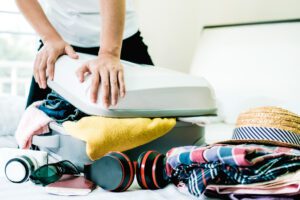 Isn’t it fun to pack your suitcase for a trip? You’re full of anticipation and can’t wait to wear your favorite clothes and that gorgeous new jacket, but then . . . the stress sets in.
Isn’t it fun to pack your suitcase for a trip? You’re full of anticipation and can’t wait to wear your favorite clothes and that gorgeous new jacket, but then . . . the stress sets in.
You’ve lined up everything you want to take and start packing, but ack! It won’t fit in the suitcase. Or everything WILL fit in the suitcase, but now you can’t lift it!
Do you get another suitcase, or do you take things out? And if you have to take things out, which ones? Suddenly, packing for your trip is not so much fun after all.
But read on, my friend, and learn to pack a suitcase like a pro. Whether you want to travel with only carry-on luggage or you just want to reduce the number of suitcases you check, I've got you covered.
In this post, you’ll gain invaluable tips, tricks, and expert advice to help you master the art of packing light while still having everything you need for your trip and looking your absolute best.
All this is brought to you by me—a girl who used to ship her clothes in a box to her destination and now can travel for 6 weeks or more in a 15-pound carry-on plus a personal item.
What is stress-free travel packing?
Stress-free travel packing is packing your suitcase in a way that allows you to take exactly what you need for your trip―and no more.
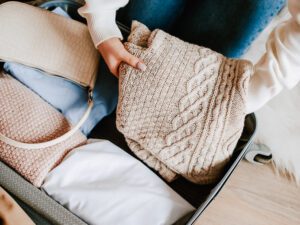
You’ll soon be saying goodbye to the hassle of overpacking, lugging heavy suitcases, and last-minute packing anxiety. Just imagine being ready to embark on your next adventure with confidence and ease.
How to Pack a Suitcase Like a Pro
How to Pack a Suitcase Like a Pro
What to pack in your suitcase
Start with a solid plan
Would you build a house without a blueprint? No, and the same goes for packing. Before tossing all your favorite clothes in your suitcase, take a few minutes to research and make a packing plan.
Here are some questions to ask yourself when deciding what to pack in your suitcase:
-
- How long will you be gone?
- Are you flying, driving, or taking a cruise or the train?
- What will the weather be like? Hot and humid weather requires different clothes than cold, dry, and windy.
- Which activities do you have planned? Do you need an evening dress for the captain’s dinner, or will a black top and slacks or an LBD with some extra makeup and sparkly jewelry work? Are you a runner? You’ll need to pack some athletic clothes. You get the idea.
- How do people dress where you’re going? You probably don’t want to stand out like a tourist.
- Are there cultural considerations? Do you need to be able to cover your head or your knees? How about footwear? Will you be taking it on and off a lot to enter buildings?
- What’s different about where you’re going? Do you need motion sickness pills, insect repellent, etc.?
- What technology will be required? Do you need power adapters? Chargers for your phones, camera equipment?
Pack light
One of the golden rules of stress-free travel packing is to pack light. Don’t literally weigh yourself down while traveling.
It’s tempting to bring extra clothes and supplies, just in case. But trust me! From my years of experience traveling the world (2.5 million miler here!), I can assure you that you will, more likely than not, return with your “just in case” and “what if” items unworn and unused. And guess what? Your destination will likely have stores where you can purchase what you need.
Just pack a few comfortable things you love. I packed for four weeks in Turkey in my Tom Bihn backpack, plus a camera case. And, I recently spent five weeks in Australia with my July Carry On Light suitcase and my Tom Bihn Synic 22 backpack packed with my laptop and electronics. Nothing weighed over 15 pounds. All carry-on.
But don’t worry! Packing light doesn’t mean you can’t check a suitcase if the carry-on concept doesn’t work for you.
Instead, think lightweight, wrinkle-resistant fabrics that don’t take up much space in your luggage. Take clothes you can layer for warmth and clothes you can launder on the go. These travel-friendly fabrics include polyester, merino wool, lightweight knits, spandex, bamboo, modal, and lyocell.
Take clothes that do double-duty
Clothes that can reverse or morph into a different clothing piece allow you to double your wardrobe without adding more weight. Check out Splice, the Wool& 100-day challenge for women, or the Wool& 100-day challenge for men to see what I mean.
If you’re a frequent traveler, keep your eyes out for clothes that fit these descriptions and curate your travel wardrobe over time. When I find clothes perfect for travel, I tuck them in my “travel box.”
Embrace the capsule wardrobe concept
What is a capsule wardrobe?
A capsule wardrobe is a curated set of travel clothes you mix and match. It’s about keeping them simple, but stylish.
Creating a capsule wardrobe allows you to reduce the number of clothes you pack but still feel comfortable and stylish. It just takes some thought and planning. The key lies in selecting a mix of pieces that can be combined into different outfits and work in various occasions and climates.
How to create a capsule wardrobe
After you’ve jotted down notes about the types of clothes you’ll need each day based on the weather and the activities you have planned, take the following steps:
-
- Select a color palette. Choose a color palette with either warm or cool colors. Then, narrow the colors down further. For example, you might choose grays with soft blues, or black with bright colors.Now’s not the time to try something new! Select colors that you know you already love wearing. If you’re looking for inspiration, Janice at The Vivienne Files creates capsules starting with a scarf or a painting.
- Choose core pieces. Pick a few neutral-colored bottoms and tops you can mix, match, and layer. In addition to being versatile, these pieces should fit well and be comfortable throughout the day.
- Add complementary pieces. These might be tops, scarves, belts, jewelry, or pairs of shoes. You want pieces that add color or a pattern. Each of these items should work with multiple outfits.
- Organize your capsule. Lay your pieces out and see how many ways your core and complementary pieces can be mixed and matched. Remove anything that can only be used once or twice.
- Pack it up. Use packing cubes, compression bags, pouches, or another organization method to pack your clothes up. Then see if they fit in your suitcase. If so, great! If not, then you’ll need to remove something.
Ideally, the items that go in your capsule are lightweight, can be layered for warmth, and can be washed and dried quickly.
A capsule wardrobe is one of the most important items for stress-free travel packing and for making sure you don’t injure yourself hefting around a big suitcase.
>>>LEARN MORE:
How to Create a Travel Capsule Wardrobe the Sudoku Way
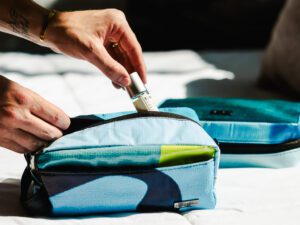
Photo by Tyler Nix on Unsplash
Toiletries and personal care
This is another area where it’s easy to bring too much. Packing everything you use at home is tempting, but full-sized bottles take up space and add weight.
Here are some tips on which toiletries to pack for a trip and how to pack them.
-
- First, consider the type of trip you'll be taking, then create a packing list so you don't forget anything. For example, if you're going on a beach vacation, you'll want to pack items like a bathing suit, sunscreen, aloe vera gel, and insect repellent. If you're traveling to a colder climate, you may need to bring moisturizer and lip balm to combat dry skin.
- See if your hotel or Airbnb provides shampoo, conditioner, and body wash. Unless you have specific hair or skin care needs, the hotel offerings should suffice.
- Next, consider all the toiletries you use daily, such as toothpaste, toothbrush, deodorant, skincare, and makeup. Look for travel-sized products. You can usually find these in your local drug store, Target, or Walmart and see if you can find travel sizes. You can also just pour products into smaller containers.
- Place these items in a small toiletry bag that can easily fit into your luggage.
- Take enough prescription medicine and key supplements for a few extra days in case your travel plans are extended. Keep them packed in the original bottle.
- If you’re flying or traveling on the train, be sure medications are in whichever bag will stay with you. Never check them!
If you’re flying within or to the US, remember TSA’s 3-1-1 rule. All liquids must be in 3.4 ounces or smaller containers and be placed in a clear, plastic, quart-sized plastic bag.
If you're not sure if an item is allowed, check the TSA website or contact your airline for guidance.
Pack your toiletry bag last to be easily accessible during your trip. If you're flying, place it on top of your other items in your carry-on for easy access during security checks.
Want more details and suggestions for travel-sized toiletries? Scroll to the bottom of this post. I've got links to other posts that will give you some good ideas for alternatives to liquids, and smart ways to pack.
>>> LEARN MORE:
Electronics and travel gadgets
Selecting the right electronics and gadgets to pack in your suitcase is key to keeping you entertained, connected, and able to capture precious memories along the way.
And because you can't always find what you need when you're on the road, assessing your needs and prioritizing the items to take is crucial.
-
-

Photo by Solen Feyissa at Usplash
Critical to stress-free travel is remembering to bring chargers and cables for your phone, laptop, tablet, camera, etc. Having a charger that can do double duty and charge several devices will save space.
- A camera is a must-have if you plan to take photos or videos during your trip. Smartphones have come a long way, and the more recent ones take excellent images. They’re a great way to capture images that will provide wonderful memories years later.If you prefer a larger camera, bring a lightweight and compact option, such as a mirrorless camera or a point-and-shoot. And don't forget to pack extra memory cards and batteries so you don't miss any important moments.
- Another important gadget to bring is a portable power bank. This can be a lifesaver when you're out and about without access to a power outlet. Look for one with a high-capacity battery and multiple USB ports so you can charge multiple devices at the same time.
- If you enjoy reading or watching movies while you’re traveling, a tablet or e-reader can be a great addition to your travel gear. These devices are lightweight and can store multiple books, movies, and TV shows. This makes them perfect for long flights or train rides. Just be sure to download your entertainment first!
- A laptop is a must-have if you need to work remotely during your trip. Look for a lightweight option with a long battery life. Make sure you also bring any necessary accessories, like a mouse or keyboard.
- If you love listening to music, then portable speakers are important to bring along.
-
When packing your tech gear, it's important to do so in a way that keeps it from getting damaged during travel.
Invest in a sturdy and protective case for your camera and laptop. Pack your valuable electronics in your carry-on to prevent them from getting lost or stolen.
Also, pack your gadgets in a way that makes them easily accessible. Use packing cubes or organizers to keep everything in its place, and consider bringing a separate bag or pouch specifically for chargers and cables to keep them from getting tangled.
By following these tips, you'll be able to enjoy your trip with all the gadgets and technology you need.
And don’t forget to insure everything before you go!
Expert advice
If you’re traveling internationally, don't forget to pack a universal adapter. And check your electronics against the voltage at your destination to see if you’ll need a converter. This will ensure you can charge and use your devices without any issues.
For a complete list of tech gear, recommendations, and packing suggestions, please take a look at the recommended posts at the bottom of this article. And if you’re traveling overseas, download my recommendation for the 7 Must-Have Apps for International Travel. Apps come, and apps go, but these are the 7 I never travel without.
>>> LEARN MORE: How to Pack Your Electronics for Travel
Travel documents and money
Whether traveling within the US or internationally, having the right documents and currency will make your trip much smoother and less stressful.
The first thing to consider is your travel documents. Depending on your destination, you may need several documents to enter and travel within the country.
- Passport. One of the most important documents you will need is your passport. If you are traveling internationally, make sure your passport is up-to-date and won’t expire during your trip. Many countries require a passport expiration date six months after you return home. Keep your passport securely located in a passport holder or a money belt so you always know where it is.
- Visa. You may also need a visa to enter your destination country, so check the visa requirements well in advance. It can take time to obtain a visa, so plan accordingly.
- Travel insurance. It’s always a good idea to have travel insurance to help cover unexpected expenses, such as medical emergencies or trip cancellations. Check your credit card first, as you may have some or all of the coverage you need.
- Itinerary. Just to be on the safe side, always carry at least one printed copy of your itinerary in addition to whatever you have on your phone. Be sure it includes flight times, hotel reservations, and any activities you have planned.
- Driver’s License. If you plan on renting a car during your trip, you'll need to have a valid driver's license. Check your destination country to see if you need an International Driving Permit.
Once you have gathered all of your travel documents, it is time to pack them up. A travel document organizer with multiple pockets and compartments is a great way to keep all your documents in one place.
- Make copies of your passport, visa, itinerary and other important documents. Keep one set of your travel documents with you on your trip. Leave another with a friend or family member at home in case your documents are lost or stolen.It also doesn’t hurt to have a digital copy on your phone.
-

Photo by Jason Leung at Unsplash
When it comes to money, research the exchange rate for the country you’ll visit before you leave on your trip. This will help you determine how much money to bring and how much to exchange once you arrive.
- Keep your money secure by using a money belt or hidden pocket.
- Bring multiple forms of payment, such as cash and two credit or debit cards. This way you'll have a backup in case one isn't accepted.Use a money clip or wallet to keep your cash and cards organized. Look for one with multiple compartments so that you can separate your currencies.
- Notify your bank and credit card companies before you go to prevent your accounts from being flagged for suspicious activity.
- And, instead of keeping all your cash in one place, split your money up in different pockets or compartments. That way, you'll still have some money if one stash is lost or stolen.If you carry significant cash, consider using a lockable bag to keep it secure.
Remember to do your research ahead of time, bring multiple forms of payment, and keep everything secure.
Expert advice
Keep receipts for any purchases you make during your trip. If you're traveling internationally, you may need them to claim any VAT tax before you leave the country and to satisfy US customs when you return in case there are questions about what’s in your luggage.
How to Pack Your Suitcase
Choose the right luggage
Well done! You've figured out which clothes, toiletries, and tech items you'll bring. Now, it’s time to select your suitcase(s) and your personal item. Your personal item is the bag you'll keep important items in while you're traveling and don't have access to your luggage.
First, you need to choose the right size and weight of luggage. You can figure that out by answering these questions:
-
- How long will you be gone?
- What activities do you have planned?
- How much weight can you lift, and will you have someone along to help?
- Do you want to check a suitcase or will carry-on do?
- What are the size and weight requirements for your airlines?
Hard-sided luggage
If you’re ready for new ultra-lightweight hard-sided luggage, check out Away and July. The Samsonite Freeform Expandable also gets good reviews.
This type of luggage will cost more, but it will be well worth it if you travel frequently.
I recently purchased the July Carry-On Light. It only weighs 3.9 pounds. Since the weight limit on my home airline is 15 pounds, and I prefer carry-on only, I can put more in this suitcase than I could if I had a heavier one.
It’s missing some pockets for organizing, but for my situation, I’m happy to give those up for the lighter weight. Even full, I can easily lift it into the overhead bin, and my backpack fits nicely over the handles.
Soft-sided luggage
Hard-sided luggage is fine unless you encounter the dreaded cobblestones, broken sidewalks, or dirt paths. Then having a suitcase you can carry beats wheels every day.
I can’t recommend Tom Bihn Travel Bags highly enough. I have the Western Flyer, which can be carried as a backpack, over your shoulder, or in your hand.
If you don’t want a backpack or don’t need any internal organization, the LeSportSac Deluxe Large Weekender might be a good carry-on. It would be a good choice for a short trip or if you have a small capsule wardrobe for longer trips. It also comes in medium if you don’t need that much space.
I like to pack an empty LeSportSac bag in my luggage because it’s so lightweight. I’ve used it for my dirty clothes or as an additional bag to bring home souvenirs or clothes I purchased on my trip.
It’s amazing how much you can fit into these bags!
Personal item
Your personal item should contain important items like your passport, visa, itinerary, credit cards, money, and medication.
It should be small enough to fit under the seat in front of you if you’re flying or on the train, and on your lap or by your feet if you're traveling on a bus.
If you’re flying, check the airline’s requirements for size and weight. With travel picking up and space being at a premium, airlines are getting stricter, and you don’t want to have to check this bag at the last minute.
Taking a purse small enough to fit into your personal item is also a good idea. That way, you don’t have to declare it as a separate item when you board.
In addition, you’ll want to include any snacks, electronics for entertainment, a sweater or a scarf, and any toiletry items you'll use on the plane. I also pack a change of clothes in case I have to gate-check my carry-on.
I don’t recommend open-totes because things fall out, especially if they’re stuffed under an airplane seat. Always look for bags with zippers.
You'll also want to use your personal item as your day bag at your destination, so consider that when choosing which one to take.
The Lands’ End Travel Carry-On Luggage Tote Bag is an affordable option. If you’re concerned about theft, try the Pacsafe Metrosafe Anti-Theft shoulder bag or the Pacsafe Convertible Backpack.
Expert advice
If you have a travel companion, you should each pack one change of clothes in the other person’s suitcase or carry-on. That way, if one of you loses your luggage, all won’t be lost.
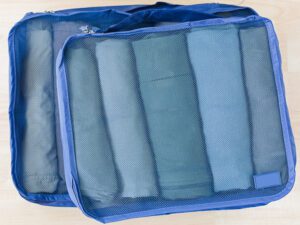 Invest in packing cubes and pouches
Invest in packing cubes and pouches
The most efficient way to pack a suitcase is to use packing cubes to organize and sort your clothes, toiletries, electronics and other travel essentials.
Some packing cubes are also compression bags that allow you to fit more clothes in the same space. Be aware of weight limits if you choose these kinds of cubes.
You can organize your clothes by type, with pants in one cube and tops in another, or by outfit with the bottoms and tops in the same cube. This saves you tearing your suitcase apart and packing it back up each day as you can easily find what you’re looking for.
A good alternative to packing cubes is to use gallon-sized resealable bags. The best way to use these is to put your clothes in eitehr flat or rolled. Then zip them almost closed, roll them to push the air out, close the zipper then flatten them out.
Pouches are small bags that are great for corraling small items like hair ties, lip gloss, and cables.
How to Organize Your Suitcase
Now, it's time to play around with how all your packing cubes and pouches will fit into your suitcase space.
First, gather everything together and then determine what will go in your checked suitcase, if you're taking one, and what will go in your carry-on.
Then, put your clothing items into categories, placing clean clothes in one section and, if you're repacking while on your trip, dirty clothes in another.
Start by putting heavy or bulky items, like jackets or thicker sweaters, at the bottom of your suitcase (the part near the wheels) to create a stable base. Place belts along the perimeter of the suitcase.
Tuck smaller items in your shoes, or use pouches or compartments to keep them organized and easy to access.
Place shoes in a small bag to keep them from getting your clothes dirty. If you have a pair of shoes that are particularly large or cumbersome (cute boots, anyone?), position them at the edges of your suitcase.
Then, fit in your packing cubes. You may need to place one or two cubes first, then your shoes, then finish with cubes. It all depends on what you’re taking. Layer any fragile items in between other items so they are padded on all sides.
Finish with whatever you may need to pull out for security during your trip or when you first arrive.
Expert advice
Collect plastic shower caps from hotels or dollar stores and put one over each shoe to protect your clothes from dirty shoes.
Final Thoughts on Packing a Suitcase
To wrap things up, becoming a suitcase-packing pro will be a game-changer for your upcoming trips.
By following these tips to pack your suitcase, you’ll remove the stress from packing and will be able to enjoy your trip without hefting around heavy luggage. Taking the time to pack your suitcase like a pro will allow you to arrive at your destination feeling relaxed and stress-free.
No more frantically searching for items or struggling with a heavy suitcase. With these tips, and the ones in the associated posts, you’ll be packing like a pro in no time!
Now go out there and make those travel memories! Bon voyage! ! 🌍✈️
Here are some other posts you may find helpful:
Pin this post to read later
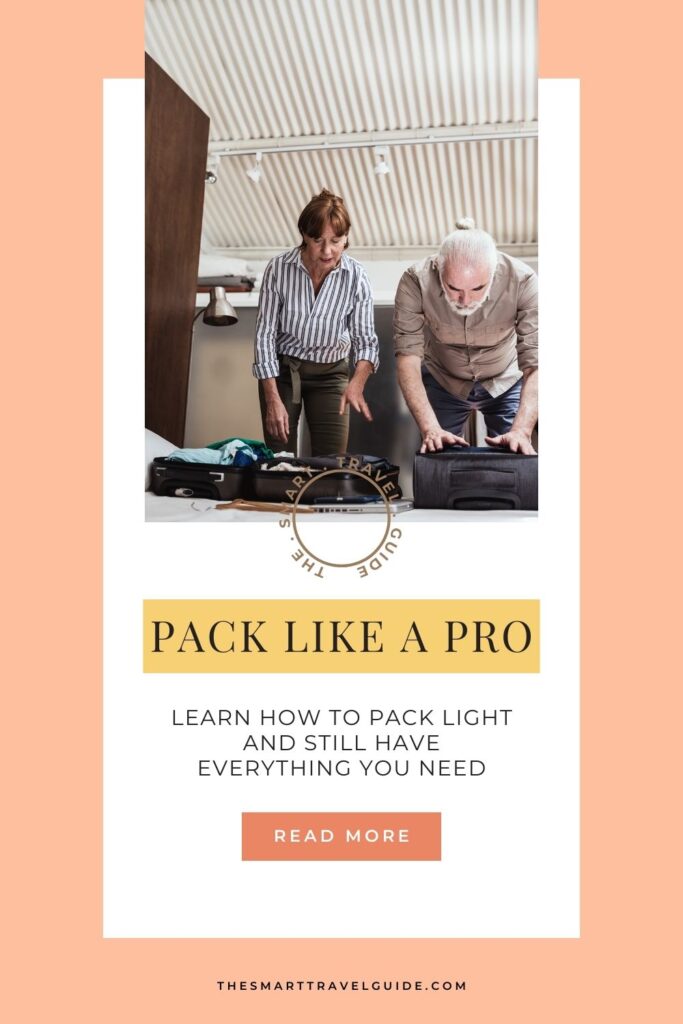

Be the first to comment